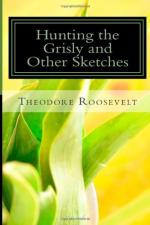Ordinarily, however, no two greyhounds or deer-hounds are a match for a gray wolf, but I have known of several instances in Colorado, Wyoming, and Montana, in which three strong veterans have killed one. The feat can only be performed by big dogs of the highest courage, who all act together, rush in at top speed, and seize by the throat; for the strength of the quarry is such that otherwise he will shake off the dogs, and then speedily kill them by rabid snaps with his terribly armed jaws. Where possible, half a dozen dogs should be slipped at once, to minimize the risk of injury to the pack; unless this is done, and unless the hunter helps the dogs in the worry, accidents will be frequent, and an occasional wolf will be found able to beat off, maiming or killing, a lesser number of assailants. Some hunters prefer the smooth greyhound, because of its great speed, and others the wire-coated animal, the rough deer-hound, because of its superior strength; both, if of the right kind, are dauntless fighters.
Colonel Williams’ greyhounds have performed many noble feats in wolf-hunting. He spent the winter of 1875 in the Black Hills, which at that time did not contain a single settler, and fairly swarmed with game. Wolves were especially numerous and very bold and fierce, so that the dogs of the party were continually in jeopardy of their lives. On the other hand they took an ample vengeance, for many wolves were caught by the pack. Whenever possible, the horsemen kept close enough to take an immediate hand in the fight, if the quarry was a full-grown wolf, and thus save the dogs from the terrible punishment they were otherwise certain to receive. The dogs invariably throttled, rushing straight at the throat, but the wounds they themselves received were generally in the flank or belly; in several instances these wounds resulted fatally. Once or twice a wolf was caught, and held by two greyhounds until the horsemen came up but it took at least five dogs to overcome and slay unaided a big timber wolf. Several times the feat was performed by a party of five, consisting of two greyhounds, one rough-coated deer-hound, and two cross-bloods; and once by a litter of seven young greyhounds, not yet come to their full strength.
Once or twice the so-called Russian wolf-hounds or silky coated greyhounds, the “borzois,” have been imported and tried in wolf-hunting on the western plains; but hitherto they have not shown themselves equal, at either running or fighting, to the big American-bred greyhounds of the type produced by Colonel Williams and certain others of our best western breeders. Indeed I have never known any foreign greyhounds, whether Scotch, English, or from continental Europe, to perform such feats of courage, endurance, and strength, in chasing and killing dangerous game, as the homebred greyhounds of Colonel Williams.




